Many people eat things that we would consider strange. However, we will discover one of the most diverse cuisines in China. Chinese folks are fond of eating. A Chinese delicacy can be anything bizarre to us. No other country could compete with a nation so dedicated to eating. They can eat anything that walks, crawls, flies, swims, slithers, or grows. If only eating could become an Olympic sport.
You can find flavorful snacks, tourist charms, and downright gross items in each street market in China. These foods are renowned for several qualities. It includes their flavors, originality, and therapeutic value.
These delicacies contain animals, plants, insects, and practically anything else. “The Chinese eat anything with four legs, except tables and chairs, and everything that flies, except airplanes,” is a proverb that seems accurate. We can say that Chinese people consume the weirdest Asian food items.
Let’s jump to our list of the top 5 weirdest Asian foods that Chinese people eat as delicacies:

Balut
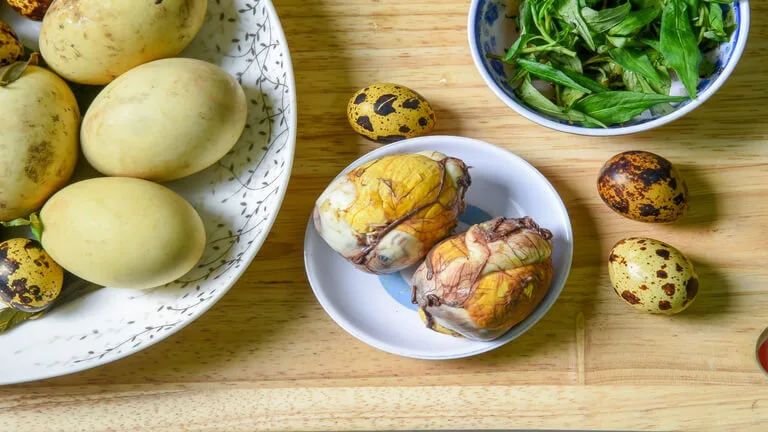
Balut is a Chinese delicacy. In the 17th century, the Philippines adopted this Chinese dish. It is now regarded as the national meal of the Philippines. That’s why it’s included in the list of weird Asian foods. According to a 2007 study, Chinese traders and immigrants introduced the practice of consuming fertilized duck eggs in the Philippines. It happened around the 17th century. The etymology is also attributed to the Chinese “Maodan,” meaning feathered egg.
Eggs are unfertilized and have many nutritional advantages for our health. Many of us are accustomed to taking them in some form without even giving them a second thought. The Chinese eat eggs in a highly distinctive manner known as balut. This Chinese delicacy is a partially formed chicken or duck egg called balut. It’s incubated for 14 to 21 days before being boiled and consumed.
A lot of street markets sell this weirdest Asian food cuisine balut. Eating a half-matured duck may sound disgusting to us. But in China and many other countries, this meal is prized. This fertilized egg is cooked for approximately 25 minutes and then consumed while still warm. Some eggs contain edible bones and feathers. According to local mythology, it makes the males appear more masculine. The yolk is described as thick and creamy with an overall mild taste.

Century Egg
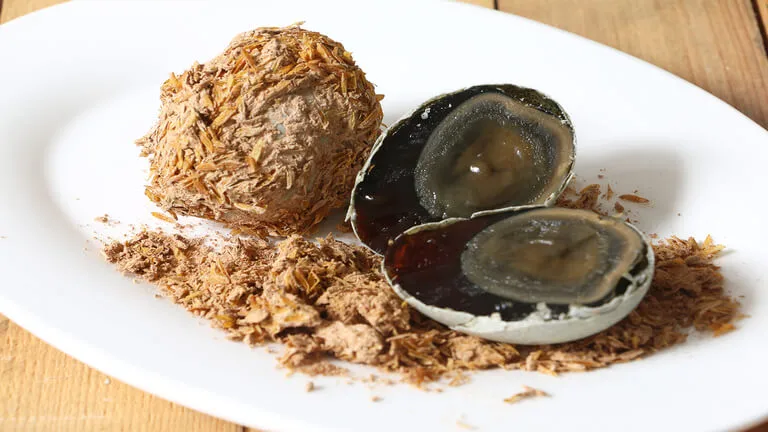
Another Chinese delicacy is known as the century egg or the preserved egg, but preparing one doesn’t truly take 100 years. A farmer invented this cuisine in rural China. He discovered some naturally preserved duck eggs in muddy water. He chose to recreate them by manual preservation after tasting them. This weirdest of Asian foods has continued to be enjoyed for centuries throughout Southeast Asia, China, and Hong Kong as a delicacy. Chicken, duck, or quail eggs are soaked in strong black tea, lime, salt, and recently burned wood ashes.
It takes a decent amount of time to achieve the desired preserved egg or century egg flavor. The eggs can be soaked for any amount of time between seven weeks and five months. The century egg has a distinctive hue and scent. The color of the egg yolk depends on the processing time. The yolk may appear yellow, dark green, or brown. However, the core is typically tender in all hues. This Chinese delicacy is described as refreshing, smooth, delicious, and salty.
A chemical reaction turns a white egg translucent. The exterior of the egg may have a snowflake design. If the eggshell isn’t cracked, Pi Dan can be kept for up to five months. The Chinese use them to make cold foods like salads or spicy lunches by combining them with soy sauce and green chilies. A popular present for loved ones during the traditional Chinese Dragon Boat Festival is century eggs.

Fried Seahorse
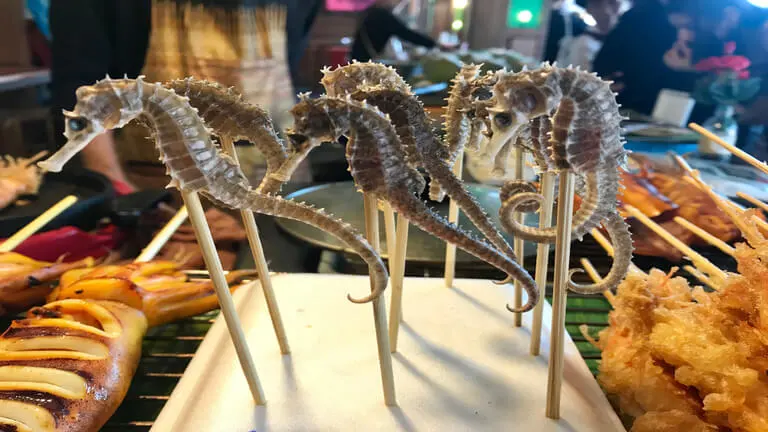
One of the adorable little fish in the sea is the seahorse. It’s a well-liked Chinese delicacy, and the Chinese eat it as a snack. Seahorse is quite salty and has a consistency similar to squid. They are frequently available at various street markets on kabobs or in soups. Seahorses include jagged particles that might catch on your gums or teeth. Therefore, you must exercise caution when eating them.
The Chinese also think eating seahorses has many advantages. According to a Chinese saying, a seahorse diet may keep an 80-year-old grandfather young. Many residents use it as a traditional Chinese vitality and performance enhancer. This Chinese delicacy can be combined with herbs and cooked as a tea to cure asthma and male dysfunction. Unfortunately, the strong demand is causing seahorse numbers to decline.

Turtle Shell Jelly
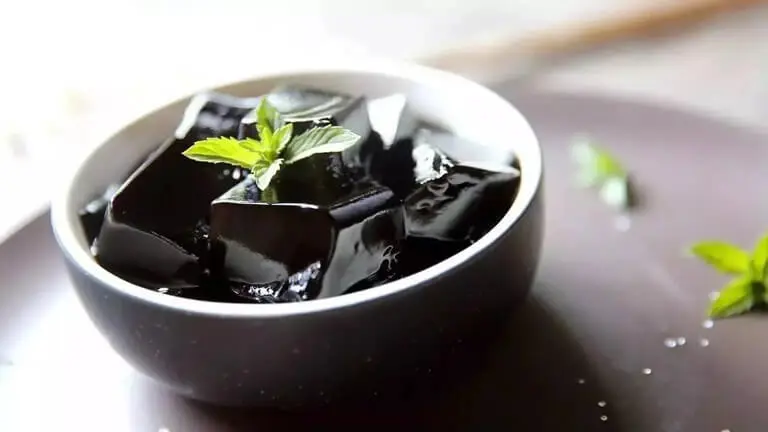
Guilinggao is a jelly-like confection popular in China. It is commonly referred to as tortoise jelly or turtle jelly. It is typically manufactured using multiple medicinal items and different kinds of turtle shells. Most turtle jelly is created from readily accessible turtle species to keep the price low. However, there are also incredibly pricey varieties that include materials from the golden coin turtle. Some turtle jelly products on the market don’t contain any turtle-derived components.
This Chinese delicacy is also utilized medicinally. It improves blood flow, supports muscle growth, and revives renal functioning. Many people think that consuming turtle jelly on a regular basis will make their skin seem better and healthier. It often has a dark brown or black hue and tastes slightly bitter. However, the Chinese add several sweets to enhance the flavor.

Bat Soup
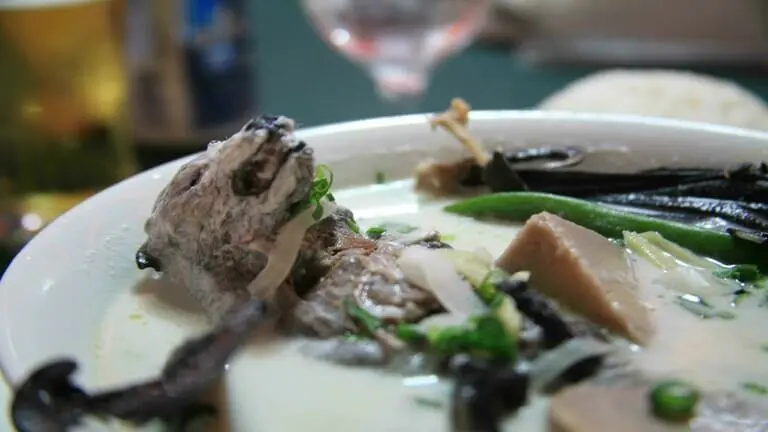
Given the situation, it would be negligent in leaving out bat soup from the list of weird Asian foods. It’s unlikely that bat-eating is to blame for the current Wuhan flu pandemic. This Chinese delicacy has undoubtedly gained significant attention. An entire bat is placed in a soup dish and then boiled in chicken broth to make bat soup. The bat is cut up using a knife and a fork. The soup and internal organs are consumed. The membranes from the bat’s wings are in the dish with the hair.
We are compelled to conclude that this Chinese delicacy is quite unappetizing to see an entire bat floating in front of us. However, it’s said to be delicious. Numerous conservation organizations believe that the practice is unsustainable because of health concerns.
More Related Article: Top 5 Five Most Expensive T Shirt Brands In The World
